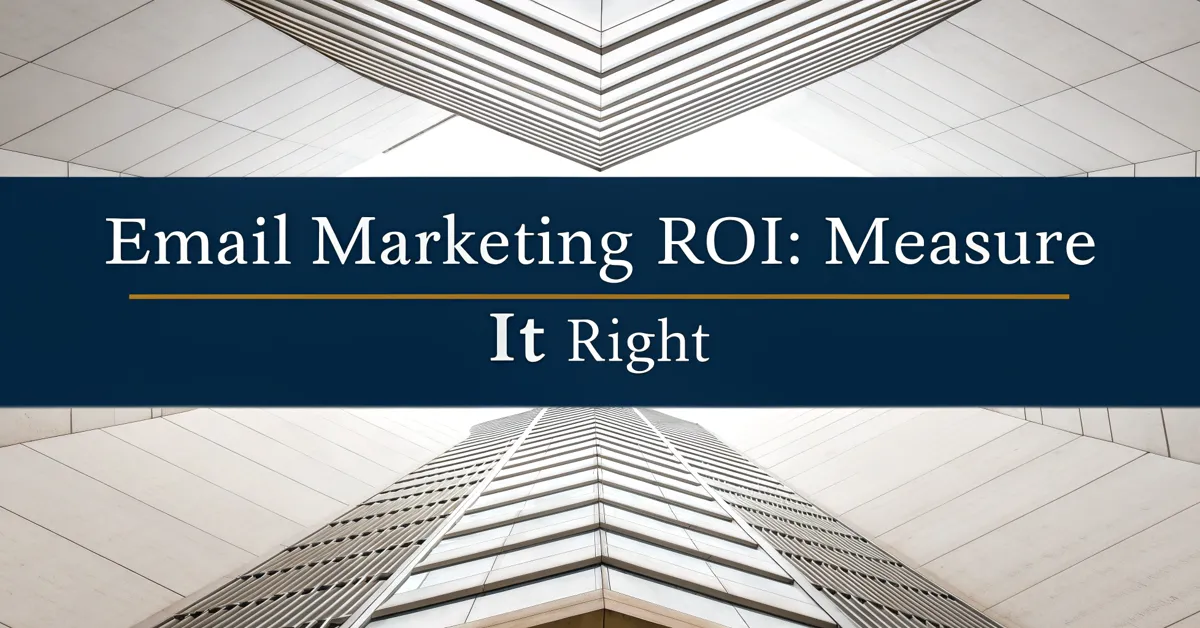Is your email marketing strategy truly working, or is it just another task on your to-do list? It’s a question many of you may ponder. You put in the time and effort, but how do you know if it’s truly worth it? You need to know your email marketing ROI. It’s not enough to just send emails, you must measure the results, and understand your returns. In this article, we’ll dive deep into the world of email marketing ROI, explore the key metrics, and show you how to measure them right.
Why Measuring Email Marketing ROI Is Crucial
Many marketers often see email as just one more channel to use. They tend to overlook how it directly affects the bottom line. If you don’t track your email marketing ROI (return on investment), you’re flying blind. You don’t know what’s working and what’s not. Measuring your ROI isn’t about just numbers. It’s about understanding your efforts and what they mean for your business. You can use this information to make smarter decisions.
When you measure your email marketing ROI, you can:
- Show the worth of your efforts: You can prove that email marketing is a smart investment, not just a drain on resources.
- Find your strong points: You can see which campaigns do very well and which ones need more work.
- Make smarter choices: You’ll know where to put your money and time for the best results.
- Improve your results: You can constantly make small changes to improve results.
- Hit your goals: You can make sure your marketing is helping your business reach its targets.
In short, tracking your email marketing ROI can help your business grow. It also helps you avoid wasting time and money on plans that don’t work.
Core Metrics to Track for Email Marketing ROI
Before you calculate the overall ROI, you need to keep track of key metrics. These are the individual numbers that show how well your campaigns are doing. Let’s take a close look at each one.
Open Rate
The open rate tells you what part of your subscribers open your emails. It’s often shown as a percentage. A high open rate might mean your subject lines are very good. Or that your audience is very engaged. A low rate might mean you need to work on your emails, or your list.
To calculate the open rate, use this formula:
(Emails Opened / Emails Sent) * 100
Click-Through Rate (CTR)
The click-through rate (CTR) shows you how many people click on a link in your email. It shows how well your content attracts people to your website. A high CTR shows that your content is interesting and useful for your audience. A low CTR means you may need to improve your content. Or make your calls to action clearer.
To calculate CTR, use this formula:
(Clicks / Emails Delivered) * 100
Conversion Rate
The conversion rate is the most important metric. It shows you how many of your email recipients complete a goal. This might be making a purchase, filling out a form, or signing up for a free trial. A high rate means your emails are really turning leads into customers. A low rate might mean your emails are not meeting the needs of your subscribers.
To calculate the conversion rate, use this formula:
(Conversions / Emails Delivered) * 100
Bounce Rate
The bounce rate is the percentage of email addresses that do not get your email. There are two types of bounces: soft and hard. A soft bounce often means a temporary issue, like a full inbox. A hard bounce means the email address doesn’t exist. It is very important to keep a low bounce rate. High rates mean issues with your email list.
To calculate the bounce rate, use this formula:
(Bounced Emails / Emails Sent) * 100
Unsubscribe Rate
The unsubscribe rate shows you how many people opt out of your email list. A high rate may show that you’re sending too many emails. Or that your content isn’t interesting for your subscribers. A low rate means you’re doing well. It shows that your audience wants your emails.
To calculate the unsubscribe rate, use this formula:
(Unsubscribes / Emails Delivered) * 100
List Growth Rate
The list growth rate shows how fast your email list is growing. It’s very important to keep growing your list. It helps you reach more people with your messages. If your list growth is not very good, then you should focus on how to get more subscribers.
To calculate the list growth rate, use this formula:
((New Subscribers – Unsubscribes) / Total Subscribers) * 100
Average Order Value (AOV)
If you’re selling products through email, you should know your average order value (AOV). This is how much a person spends per purchase. It can give you ideas on how to improve your marketing. For example, if you’re offering discounts, you should see if the AOV also goes up. Or if it goes down.
To calculate AOV, use this formula:
(Total Revenue / Number of Orders)
Customer Lifetime Value (CLV)
Customer lifetime value (CLV) shows how much a customer spends during their time buying from you. Knowing this will help you to see the long-term effect of email marketing on your revenue. If you are retaining customers, you should see the CLV go up. If you are losing customers, you should see the CLV go down.
To calculate CLV, use this formula:
Average Purchase Value * Average Purchase Frequency * Average Customer Lifespan
Cost Per Acquisition (CPA)
The cost per acquisition (CPA) shows you how much it costs to get one new customer with your emails. You can use this number to improve how you do marketing. You can also use this number to know how much to spend on email marketing. If your CPA is too high, you will need to cut costs. Or make your emails more efficient.
To calculate CPA, use this formula:
(Total Marketing Cost / Total Number of Conversions)
Revenue Per Email (RPE)
Revenue per email shows you how much money you make from each email you send. It’s a good metric to see the true value of your campaigns. If you are sending good emails, you should see a higher RPE.
To calculate RPE, use this formula:
(Total Revenue / Emails Sent)
Tracking all of these metrics may seem like a lot. But each one helps you see a small piece of the bigger picture. By watching each metric, you can improve how your email marketing works. This will lead to better results and a higher ROI.
How to Calculate Your Email Marketing ROI
Now that you know the key metrics, let’s talk about how to find your overall email marketing ROI. It might seem hard, but the formula is very easy to use.
Here is the basic formula for calculating email marketing ROI:
ROI = (Net Profit / Total Investment) * 100
Here’s a more detailed breakdown of how to apply this to email marketing:
- Calculate Total Revenue from Email Marketing: This is the total amount of money you’ve earned from sales or other actions that started with an email. Use the data from your website, or your CRM to find the numbers.
- Calculate Total Investment: This includes all the costs you’ve spent on email marketing. This includes software, labor, design, and any other relevant costs.
- Calculate Net Profit: This is the difference between total revenue and your total investment. Subtract your investment from your revenue.
- Apply the ROI Formula: Divide the net profit by the total investment and multiply by 100 to get a percentage.
Here is a made up example:
- Total revenue from email marketing: $10,000
- Total investment in email marketing: $2,000
- Net profit: $10,000 – $2,000 = $8,000
Now, let’s apply the formula:
ROI = ($8,000 / $2,000) * 100
ROI = 4 * 100
ROI = 400%
In this case, you have a 400% ROI. It means for every dollar you spent, you made four dollars back.
Here is another example, this time with numbers that might be closer to reality:
- Total revenue from email marketing: $2,500
- Total investment in email marketing: $1,000
- Net profit: $2,500 – $1,000 = $1,500
Now, let’s apply the formula:
ROI = ($1,500 / $1,000) * 100
ROI = 1.5 * 100
ROI = 150%
In this case, you have a 150% ROI. It means for every dollar you spent, you made one dollar and fifty cents back.
When calculating ROI, it is very important to track ALL costs. Don’t just include the cost of your email software. Include your team salaries. Include the cost of any other tools you use. Include the cost of any freelancers you might use. Also, always use the same time frame to make it a fair comparison.
While the basic formula gives you a start, you should use more advanced ways to understand your ROI. You must look at the long-term effects of email marketing. Look at how it helps to build customer relationships. These are things a simple ROI number will not show you.
Common Mistakes in Measuring Email Marketing ROI
Lots of marketers make mistakes when they measure their email marketing ROI. These errors can hide useful insights. They may also give false results. Let’s check some common mistakes.
Not Tracking All Costs
Many people forget to include all the costs when calculating ROI. They might just consider the cost of their email marketing platform. But they may forget about the labor costs, design, or other tools used. If you don’t include all costs, your ROI will be artificially inflated. It will not be realistic.
Focusing Only on Direct Sales
Some may only focus on the direct sales from email marketing. They forget about the other ways emails help. Like how it improves brand loyalty, or how it helps to build long-term relationships. If you only focus on direct sales, you will underestimate the true value of your email marketing.
Ignoring the Customer Lifetime Value (CLV)
Not all customers buy only one time. Many return to purchase again and again. That’s why you need to track Customer Lifetime Value (CLV). It tells you how much a customer spends with your company. If you do not take this into account, you will not see the real effects of email marketing. It is very important to consider the long term results.
Not Using Proper Attribution
Attribution means knowing where your conversions come from. If you don’t use proper attribution models, you will not know which channels are truly driving your results. You may incorrectly give credit to your email marketing for sales that came from another source. That’s why you must have proper tracking for all channels, not just email.
Not Setting Up Goals
To track ROI you must define your goals first. You must have clear targets for your email marketing. This will help you see if you are reaching your goals. For example, do you want more subscribers, more sales, or more engagement? If you do not have goals, you will not be able to measure your performance.
Neglecting A/B Testing
A/B testing is an important part of email marketing. You need to test different things, like subject lines, content, and calls to action. If you do not A/B test, then you will not be improving your marketing. Also, you will not know what is working. And what is not.
Not Segmenting Your Audience
Email segmentation helps you send emails to smaller groups of people. They have things in common. If you send all of your emails to everybody, you will not see good results. That’s why you should segment your audience based on interests, past purchases, demographics, or behavior.
Avoiding these mistakes will help you accurately measure your email marketing ROI. You will also find new ways to improve your results. This will help you make smarter choices and better use your resources.
Improving Your Email Marketing ROI
Measuring your ROI is just the first step. The real goal is to increase your ROI. This means making your email marketing more efficient and effective. Let’s go over some ways to do this.
Improve Your Email List Quality
It’s not always about the size of your list. It’s about the quality. Make sure your list is filled with people who are really interested in what you have to offer. To do this you can:
- Use double opt-in: This means people must confirm their subscription. This will make sure they are really interested in your emails.
- Clean your list often: Remove inactive subscribers. This will help improve your delivery rates. Also, you will see better engagement.
- Segment your list: Send tailored emails to specific groups. This helps make your message more relevant for each segment.
Craft Compelling Subject Lines
Your subject line is the first thing people see. It’s very important to make it interesting. You can:
- Use urgency: Create a sense of need with words like “limited time” or “today only”.
- Use personalization: Include the subscriber’s name for a more personal touch.
- Use numbers: Numbers tend to draw attention. They also make your email more specific.
- Ask questions: Questions will create curiosity. This will make more people open the email.
- Test different subject lines: Use A/B testing to see which subject lines get more opens.
Optimize Your Email Content
The content of your emails must be interesting and useful. This will make your subscribers want to read and act on your emails. You can:
- Write clear text: Keep your text brief and easy to read. This will make sure your main points are easy to understand.
- Use visuals: Add images, videos, or GIFs to make your email more interesting. But do not overdo it.
- Use calls to action (CTAs): Use direct and clear CTAs like “Shop Now” or “Learn More”.
- Personalize your content: Tailor your content to each segment’s needs and desires.
- Make your emails mobile-friendly: Most people read emails on their phones. Make sure your emails look good on all devices.
Use A/B Testing
A/B testing is how you improve your emails. You must always test your emails. Small changes can have big results. You can:
- Test different subject lines: See which subject lines cause more people to open your emails.
- Test email content: See which content makes people click more.
- Test CTAs: Find which CTAs make people convert more.
- Test send times: Find the best times to send emails. This will give you better engagement.
Personalize Your Email Campaigns
Personalization is not just using the subscriber’s name. It’s about sending them content that matches their interests and past actions. You can:
- Use dynamic content: Use content that changes depending on what you know about each subscriber.
- Send emails based on behavior: Trigger emails when subscribers do certain actions. Like abandoning a cart or clicking on a specific link.
- Use segmentation: Make sure you’re sending the right emails to the right people.
Track and Analyze Your Results
You must watch your email marketing performance. See how well your emails are working. Make changes based on what you learn. You can:
- Use analytics tools: Use tools that give you deep insights into your email data.
- Track your key metrics: Look at your open rates, CTR, and conversion rates.
- Make changes often: Always make small changes based on what you see in your metrics.
Understand Your Customer Journey
You can also improve your ROI by watching what happens after the customer opens your emails. Track what happens after they click a link in the email. Is the website easy to navigate? Is the checkout process fast? If not, improve these. This will improve your overall ROI.
Improving your email marketing ROI is a process that takes time. But with careful planning and constant change, you can see great results. Remember, it’s not just about sending more emails. It’s about sending the right emails. To the right people. At the right time.
Tools to Help You Measure Email Marketing ROI
Measuring email marketing ROI can be hard work. You need the right tools to help make it easier. There are many tools out there that can help you, let’s see some of them.
Email Marketing Platforms
Most email marketing platforms have built-in analytics. These show how well your emails are working. These can give you useful data on:
- Open rates
- Click-through rates
- Bounce rates
- Unsubscribe rates
- Conversion rates
Many also have tracking features. These features let you see which links people clicked. And how many people made a purchase. Examples include:
- Mailchimp: A popular platform with detailed reports on all aspects of your email campaigns.
- Constant Contact: Another great platform with easy-to-use dashboards that help you analyze your results.
- ActiveCampaign: It combines email marketing with CRM features. This platform gives detailed insights into your customer’s journey.
- GetResponse: This platform offers tools like landing pages and automation workflows. These give you a complete marketing view.
- ConvertKit: A platform built for creators. It offers features to track subscriber engagement and sales.
Google Analytics
Google Analytics is an important tool to track website traffic and conversions. You can see where your email traffic is going. And how your users behave on your site. You can:
- Set up UTM tracking: UTM parameters help track traffic from different email campaigns. You can use this to see which emails drive more traffic.
- Track conversions: Track which emails lead to people buying something, or taking other actions.
- Analyze user behavior: See how email users use your site. See which pages they visit, and how long they stay.
CRM (Customer Relationship Management) Systems
CRM systems help track customer interactions. You can integrate your email data with your CRM. And see how your campaigns impact your leads and customers. You can:
- Track customer behavior: See customer’s history with your business. See how your email efforts affect them.
- Manage leads: Track leads from your email campaigns and see where they are in the sales process.
- Segment your audience: Use your CRM to group your customers. Then you can send targeted emails.
- Measure revenue: Connect your email data to your sales data. You can see how email campaigns help grow your sales.
Some popular CRM systems that combine well with email marketing are:
- Salesforce: A complete CRM with marketing tools. It provides good data on customer engagement and sales.
- HubSpot: An all-in-one marketing, sales, and CRM platform. It offers ways to see your entire marketing efforts.
- Zoho CRM: A great option for small and large businesses. It offers email automation and customer management tools.
- Microsoft Dynamics 365: Part of the Microsoft ecosystem. It offers marketing and sales tools.
- Pipedrive: A sales-focused CRM with features to manage email marketing and sales pipeline.
Spreadsheet Software
Spreadsheet software like Microsoft Excel and Google Sheets can also help. You can use them to make reports and analyze your email data. You can:
- Import email data: Bring your data from different sources into a single file.
- Calculate metrics: Use formulas to calculate your ROI, conversion rates, and other key metrics.
- Create charts and graphs: Use these to understand your data better.
Conversion Tracking Tools
These tools help track conversions from your emails. You can use them to see which campaigns are getting you sales. These include:
- Google Tag Manager: A tag management system. It lets you add and manage conversion tracking tags on your site.
- Facebook Pixel: Helps you track conversions from your Facebook ads. You can integrate it to measure emails also.
- Other marketing platforms: Many marketing platforms offer their own conversion tracking.
Using a mix of these tools gives a more complete picture of your email marketing performance. You can use these tools to track results, improve your campaigns, and boost your ROI.
The Future of Email Marketing ROI
Email marketing continues to be a key strategy for businesses. The future of email marketing ROI will involve lots of changes. It’s important to stay on top of these trends to be effective. Let’s see what the future might hold.
Artificial Intelligence (AI) and Machine Learning (ML)
AI and ML will play a larger role in email marketing. These tools will help automate many tasks, and improve the effect of email marketing. You might see:
- Personalized content: AI can analyze data to personalize email content. This will be very specific for each subscriber.
- Predictive analysis: AI will be used to forecast which campaigns will do very well. This will help you use your resources better.
- Smart segmentation: AI will make it easier to segment your audience. It will do this based on behavior, interests, and past purchases.
- Optimized send times: AI algorithms will pick the best times to send emails. They will do it by looking at user behavior.
- Automated A/B testing: AI will test different elements of emails. It will do this automatically. It will improve your ROI with very little input from you.
Enhanced Personalization
Personalization will become even more important in the future. Email marketing must feel like a one-to-one conversation. You will need to use:
- Dynamic content: Tailor content using user preferences, behavior, and data.
- Behavioral triggers: Send emails when a user does a specific action.
- Real-time data: Make use of real time data to make decisions in real time. This can help to send timely, relevant messages.
Increased Automation
Marketing automation will grow to make email marketing even more efficient. You will see:
- Automated workflows: Set up complex email sequences. These emails will be sent based on customer actions.
- AI-driven automation: AI will make it easier to automate decisions. Like who to send an email and when.
- Better integration: Tools will be better connected. Email will blend with CRM, social, and other marketing channels.
Focus on Privacy and Compliance
Data privacy will become more important. Businesses will have to:
- Follow privacy rules: Follow laws like GDPR and CCPA. Make sure to protect user data.
- Be transparent: Be clear about how you use user data.
- Get user consent: Always get users’ agreement before sending marketing emails.
Better Measurement and Attribution
Getting accurate ROI will become a priority. You will see:
- Improved attribution: Better ways to track conversions from multiple channels.
- More detailed metrics: More metrics that will show how emails impact the customer journey.
- Dashboards: You will see tools that make it very easy to view key metrics in a user friendly way.
Interactive Email
Interactive emails will grow as a way to engage subscribers. These will include:
- Polls and quizzes: Include these directly in the email to engage users.
- Shopping carts: Let users add products to a cart right in the email.
- Videos and GIFs: Use moving images to make your emails more interesting.
The future of email marketing ROI will involve using new tech, focusing on personalization, and following strict compliance rules. If you keep up with these trends, you will see better results.
The Value of Knowing Your Email Marketing ROI
Knowing your email marketing ROI is not just about seeing numbers. It’s about understanding the true effect of your marketing. It helps to show the value that email provides to your business. You will gain a lot when you make this a priority:
- Accountability: Tracking ROI makes you accountable. You will be able to see if your efforts are working. If they’re not, you can improve.
- Clear Goals: Measuring ROI helps you set specific, measurable goals for your email marketing.
- Efficient Use of Resources: You will be able to use your money and time wisely. You will invest in the channels that get the best return.
- Improved Strategies: You will be able to make changes based on real data. This helps you make your marketing better over time.
- Better Business Decisions: Knowing your ROI helps make smarter choices. It ensures email marketing is in line with your business goals.
- Proving the Value of Email: You can show to your team and bosses that email marketing is very important. It’s not just another task to do.
- Long-term Growth: A high ROI means you are building a strong marketing system. This will lead to long-term, sustainable growth for your business.
If you want to make a bigger effect with your marketing, you must track and improve your email marketing ROI. The data will tell you what’s working and what’s not. You can use this information to grow your business.
Time to Act: Making Email Marketing ROI a Priority
Email marketing is a very important part of any marketing plan. To truly understand its value, you have to be able to measure its ROI. It might seem difficult at first, but with the right approach, it becomes easier. Knowing your ROI isn’t just a good idea, it’s very important to the success of your marketing strategy. If you prioritize measuring and improving your email marketing ROI, you can make smarter choices, grow your business, and truly see your efforts lead to results.





